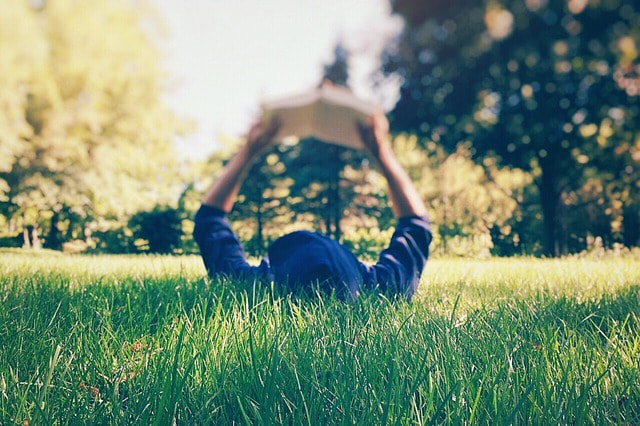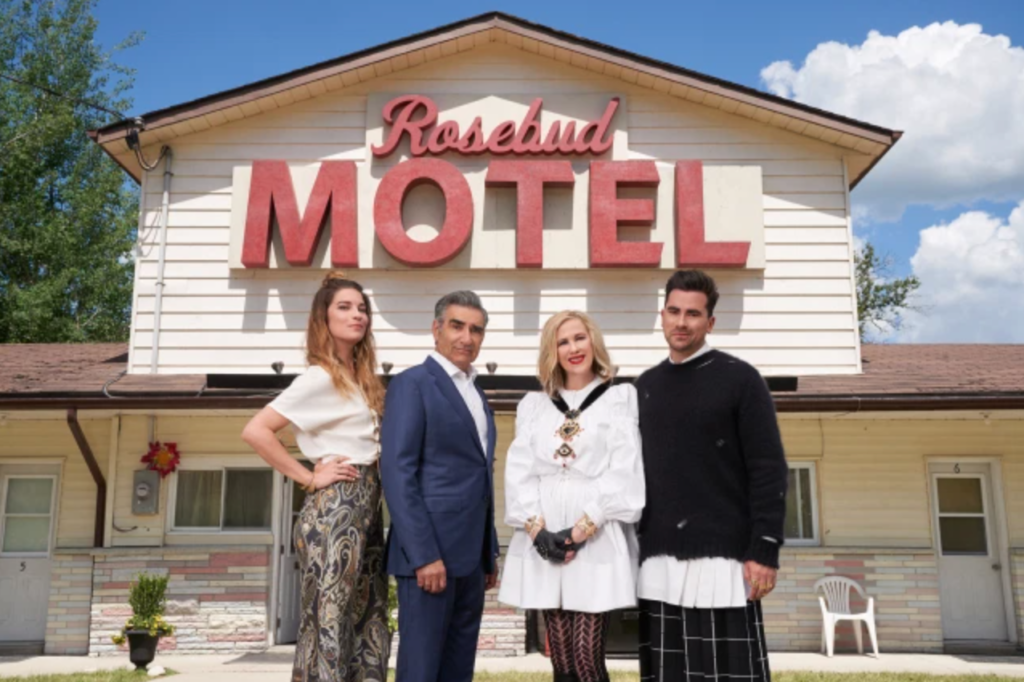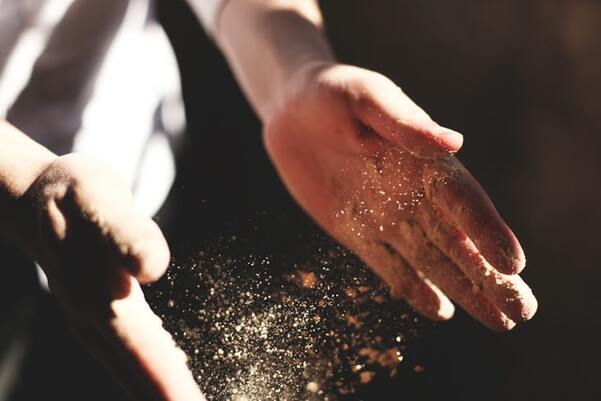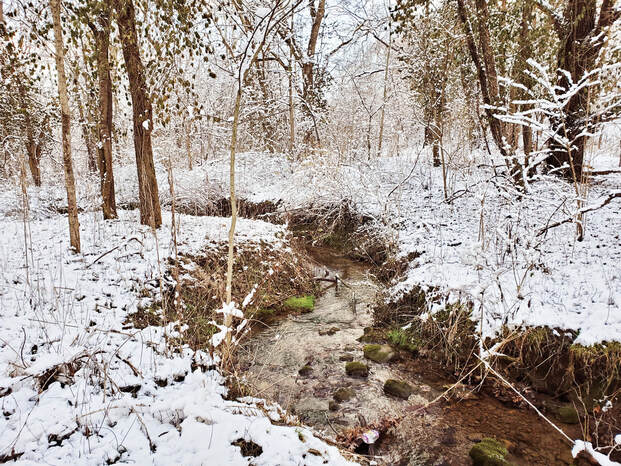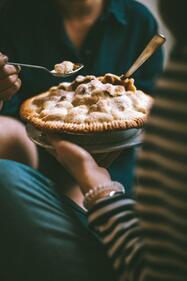 When I was a kid, my family used to spend Thanksgivings on the farm. The idyllic, iconic American experience. Mamaw would spend days shopping and chopping, and woke before dawn to start the turkey. She always had everyone's favorite pie. Dinner would involve, among other things, three different pans of stuffing: one with everything; one with no onions; one with no giblets. Plus the copious amount of sides including deviled eggs in a giant Tupperware container–because if you don’t have deviled eggs, is it really even Thanksgiving in Kentucky? All of it would somehow fit on the table that also seated 6 adults. (The 4 kids were relegated to a card table in the den, of course). As that turkey roasted to the perfection that only childhood memory can muster, I was outside with my cousins, playing on the tire swing and jumping in hay bales. The barn smelled like tobacco and Novembers were warm. This is not a Norman Rockwell imprint on my psyche. It was actual life. You don’t know when you’re having the last one of those before life happens and people grow up, and everybody gets jobs and car payments and a set of in-laws. But at some point, all those dominoes started falling. Thanksgiving migrated to my aunt’s house in Georgia, and I married into a very large Catholic family where Thanksgiving was less an exercise in finding space for the deviled egg and more a game of Twister to get everyone seated. Then I moved. To Phoenix. We lived in three different places in 7 years there, transient in they way of Gen Xers in general, and Arizona residents specifically. We had good friends from home living in Southern California. When you’re a Kentuckian living in diaspora, the 5-hour plus drive across the desert seems like nothing at all, and so the Cali-Kentucky contingent would come to Phoenix to spend Thanksgiving with us. Those years involved the gradual introduction of babies (ours and theirs) and friends’ husbands, and an ever-expanding table of mostly vegetarian fare. The church I was serving at the time always had a big Thanksgiving meal the Sunday before, which meant turkey with an abundance of jello-dishes and store bought salads because– THIS JUST IN– Arizona people don’t cook like your Kentucky Mamaw. But they have their own virtues. For instance, those were the years I learned to put green chiles in everything. Seriously, corn pudding, cheese grits… whatever, it will change your life. Somehow, even though ministry life means that holidays are the worst possible time to go ‘home,’ that desert was filled with all the goodness of family and belonging that I could ask for. Maybe it’s because there was so much love in the scrappy little church that made a pastor of me. Maybe it’s because my friends and chosen family were willing to drive across the desert just to hold my babies and enjoy pie-for-breakfast-Friday (my favorite, if self-appointed holiday). Or maybe it’s because home is not a place you go, but something you take with you. During our years in Kansas City, Thanksgiving was a pieced together thing. Some years we would go to a friend's house rather than burning up the road to Kentucky; one year, I made a midnight run to the airport, in the snow, to pick up my mom. Sometimes we traveled, sometimes we set the table. All told, in our first 15 years of marriage, my husband and I lived in 3 states: 3 Cities, 3 timezones, and (I’ve lost count but roughly) 9 different houses and apartments. There were times I felt untethered; years I wished I could transport myself to a Rockwell-esque farm scene and whatever ‘home’ means when you’re missing it; times I wished that we had “a holiday tradition” that was just what we did every year, no matter what, and we didn't have so much stuff to figure out. But that sense of lack and longing isn’t what I remember. I remember holidays from those transient years as enforced sabbath time. A few days to breathe in the goodness of our current life situation, wherever that happened to be, and enjoy it with whatever friends and family we could scrape together. Wherever we were, and whoever was there, was exactly who and what we needed at the time. We are back in Kentucky now, and like the rest of the country, heading into our 2nd pandemic Thanksgiving. So on the one hand, we have plans for about 3 different gatherings to ensure that we hit all sides of the family. On the other hand, we've got a kid at home who is technically COVID positive (though asymptomatic, thankfully) who is supposed to quarantine through Thanksgiving day. We'll do another round of tests on Wednesday and see what's what. But the past week has been a reminder that it's best to stay flexible and know that 'plans' are rarely more than good intentions. And that even our best traditions will give way to real life. The holidays came around last year at the height of the pandemic, before a vaccine was available. All experts advised that Americans forego their usual family gatherings and celebrate at home... but some folks just couldn't get their heads around it. While many sacrificed and planned family Zoom calls and Googled how to make turkey for 4, or 2, or 1... many, many others went on with holidays-as-usual, having no frame of reference for how one might just... not. And we had a massive January COVID spike to show for it. And yes, the holidays last year were kind of a bummer... But I was very mindful that the art of being unattached to tradition served us well through that time. And it continues to serve us still. There is a certain resilience that comes with having moved and changed your life a lot over the years, a bloom-where-you're-planted flexibility that embraces your current location, both literal and figurative. And one does not have to make geographical moves to cultivate such resilience. Anyone who has ever scraped together a sense of community from a hodgepodge assortment of people in close proximity will tell you the same. When your tradition is no tradition, you make it work. You give thanks for where you are. Like many of yours, our family table will be missing a loved one this year. The grief is palpable. But there is also real Thanksgiving for the life that was, for life that remains, and for those who are still with us to celebrate. Nothing is ever the same as it was when we were kids. In fact, things are rarely the same as they were just a year ago. But I know that my truest understanding of gratitude has grown out of the years when nothing seemed normal or usual... but when I could still look around and see how blessed I was by whoever happened to be in proximity. Because it's really not about holidays at all, but about finding home. And home, it turns out, is portable. Like the Derby pie I took to Thanksgiving potlucks in both Arizona and Kansas– because if you can believe it, there are folks living in those distant lands who have never thought to put bourbon and chocolate chips in their pecan pie. Home can happen at any table where you happen to be, in any season, in any timezone. Maybe home is just where your pie is.
1 Comment
Oh the joys of a summer trip to the library… my kids piling up more books than they can carry, me grabbing a few new release novels that will inevitably rack up late fees, and a few things I’ll never actually read (cause you’ve gotta have a backup)-- and then going home for an afternoon of family reading time and maybe getting ice cream drips on a few pages. Bliss.
This was one of the things I missed most during the pandemic. Our library was entirely closed for the longest time, and then they did “curbside pickup only” which was fine but all things considered, hard to plan for and utterly unsatisfying. I missed the roaming and browsing, and the flexibility to just go when we had a few minutes and were in the neighborhood. I missed finding and picking up things I’d never heard of. I missed watching my kids go to their favorite sections and totally nerd out over things I know nothing about. Add these tiny joys to the long list of things I will never take for granted again. Now the library is back! And it’s summer! Let the people rejoice. Also… what are we reading?? While I had a hard time focusing on ANYthing early in the pandemic, I got my reading mojo back about 6 months ago. I’ve also discovered the gift of audiobooks in recent times, so between the actual paper reading and the listening, I’ve covered some pretty good territory this year. The past year-plus has been a good reminder that a book can take you places, even when you can't go anywhere. As we (hopefully) start to go ACTUAL places again, here are some titles that I highly recommend for your summer roadtrip/hammock-lounging/beach-bumming/mountain climbing/porch-sitting adventures.
Every one of these books, in its own way, has the ‘sense of place’ factor--which is to say, the power to take you places-- that makes a book magical. So whether you need a book to take on the road this summer, or you need a book to actually be the road that takes you--we’ve got you covered. Happy trails!  Yesterday I grabbed the last package of pecans from the baking aisle in Kroger. Clearly all of Louisville is doing what I’m doing today--baking Derby pies. Shoot, I can’t say that. The official name is trademarked, so let’s just say, I am making chocolate pecan pie (or walnut, if you fancy), using a heavy hand with the bourbon. There may be some on the side for sipping. Of course, when I say “all of Louisville,” I mean those in my fair city who are not actually going to Churchill Downs for the race. My confession is, I’ve never been to the track ON Derby Day. But honestly, if you aren’t going to pay a 5-digit ticket price for a luxury box, you are just going to stand in the muddy infield with all the drunk frat guys who don’t know the words to My Old Kentucky Home. No, thank you. I prefer to enjoy my pie with a few close friends, the NBC Sports’ view of the whole track, and bourbon refills that you don’t have to wait in line for. You don’t have to be at the track to enjoy Derby Day. Actually-- you don’t even have to be in Kentucky to enjoy Derby Day. I can attest to this after years of having lived “elsewhere,” marking the day as “National Homesick Kentuckian” day--crying into my bourbon even as we sang “weep no more, my lady,” sharing pie with whomever was around, and trying to help my friends and neighbors in Phoenix, then Kansas City, understand what this whole thing was about. Because if you know, you know, but if you DON’T know… well, it just seems like a big lot of fuss for a horse race. In those away years, I always tried to share the experience with the people in my proximity as best I could. I would say that my transplanted traditions ‘took’ better in some locales than they did in others… But everywhere, everybody loved pie. You can’t argue with the power of pie. In fact, I have made and shared Derby Pie in so many other places, with so many other gatherings that now, this thing that used to make me homesick for Kentucky now makes me homesick for other places and people. How is that possible? This is Kentucky’s THING! Kentucky’s day. And yet-- anyplace I’ve taken this pie is also home. I guess home is where your pie is. This time last year, COVID-19 meant no Derby… Churchill Downs, like every other public place, was shut down tight and silent. The race was postponed until September when, in a truly spooky and post-apocalyptic feeling broadcast, the horses ran with no spectators. No juleps, no fancy hats, no drunken frat guys singing the wrong words loudly…just the sound of hooves on dirt. It was as though the whole pandemic had been distilled into a single, empty, two minute event. We gathered on our patio with a small group of friends, the T.V. having been moved outside for a socially-distanced watch party. As the opening strains of Stephen Foster carried across the airwaves from that impossibly empty place, my daughter said, “are you CRYING?” like it was weird or something to be crying over a horse race. I said “every Kentuckian everywhere is crying right now. Believe me.” If you know, you know. But if you don’t know… well, it just seems like a big lot of fuss for a horse race. Watching the race from just a few miles away that day felt a lot like watching it from Arizona. So close, but so far… So removed from the place itself, but so connected to every other homesick Kentuckian in the world, every other piece of traveling pie... I will watch again today-- on a friend's patio, from just a few miles away. While Churchill Downs will be at about half capacity, there will be spectators. But I don't feel the need to be there in person. It is possible to feel homesick even when you are at home. It is possible to feel connected to home, even when you are nowhere near it in proximity. And it is not just possible, but highly probable, that a certain food, or song, or sound of hooves-on-turf, can transport you instantly from home to elsewhere, and back again. Because home is not so much a place as a longing; a thing that you take with you everywhere and, hopefully, share with anyone who happens to be in your orbit. Home is where your pie is. “It is getting tricky for me to fix your hair... I feel like I am having to reach UP for the top of your head.”
It was the night before her first day of in-person school. After a year-plus of at-home virtual learning, 8 months into her 6th grade year, she was actually going to be in the building. This gradual, part-time ease into school at the very end of the year felt incredibly anti-climactic in some ways. But in others, it was huge. And so, I realized, was my daughter. For the last year or so, she has been allllllllmost as tall as me. Starting to borrow my shoes. She walked up to me the other day while I was standing in line at the grocery store, put her arm around me and said, “what’s up, Shorty?” And she was looking me square in the eye. And here we were, on the eve of her real live Middle School career-- asking me for a rare blow-dry because FIRST DAY OF SCHOOL (even if it is April); and I realized that the window of her being the same height as me had lasted all of 24 hours. I was literally reaching UP. “Wait, turn around,” I said. I shifted her around so we were standing back to back in the mirror, and there it was. It was obvious-- this child is taller than me. This will surprise no one who knows my family. I am 5’2”, so being “taller than mom” is not a huge achievement around here. And my husband is 6’7” in his socks, so we all knew this day of reckoning with his gene pool was coming for me. Still. She had a moment of delighted, if slightly baffled laughter, as I looked UP at this child I created from scratch. And then she said, all seriousness, "I could sit in a chair, if you need me to..." It may come to that soon, it really might. But for now, I can still reach her. And for now, I am just sitting here in awe at how much time marches on. Even in a lock-down year when time seemed to be standing still most days. The kids were growing-- and growing right past me--every second. * * * We have this little dog, a Jack Russell(ish) named Van Halen. He is mostly just “Van,” unless he’s in trouble, in which case it is his full name. We got him from a rescue when he was probably a year to two years old. This was a year before our daughter was born, so we calculate his age as “Harper-plus-2.” Which means he is probably about 14 now. Maybe 15, at the high end of counting. I don’t have to tell you that, in dog years, that is getting up there. He still gets around pretty well for an old man, though he is starting to do strange old dog things. He doesn’t hear very well so you have to get really close to call him now. He is getting much less tolerant of small children, strangers, and really, people in general who want to touch him or be in his space. And most recently--sometimes, in the evening, he will just cry for awhile. It is truly pitiful to see this dog who has always been so full of life and boundless energy just roaming or sitting in his favorite chair, whining for no apparent reason. I have figured out this behavior correlates with Tuesday nights, when dad has band practice at a friend’s house and is out late. When he’s gone to work during the day, Van is fine. But if it gets past dark and he’s not around, there is something unsettling about that for the dog. I wonder if it is, in some ways, a creeping doubt about his ability to be the Alpha and protect the family when his man-person isn’t home. Then again, perhaps I am reading too much into the existential struggles of a dog. Maybe his joints just hurt more at night. Maybe he needs more attention. Maybe he is just sad. Or maybe he knows that, even in the times when every day seems the same, when a year goes by and we’ve scarcely left the house, when nothing else has been certain or predictable or really seemed to “happen” at all… time just keeps coming. And at some point, we stop growing and just get older. * * * Wednesday was the weirdest weather day I have ever experienced. And I’ve lived in Kansas, where you can have a blizzard one day and a tornado the next. I’ve lived in Arizona, where the “fall” means you need a heavy jacket in the morning, and by afternoon it will be 105 in the shade. We woke up, this third week of April in Kentucky, to snow on the ground. By late morning, the sun came out, and the snow was melting in huge, clumsy clumps that sounded like someone throwing snowballs at my roof. By noon, it was sunny and all the snow was gone. And then, about 2pm, it started snowing again. Big heavy, wet snow that stuck to nothing, but came down for a solid several hours all the same. It went on like this all afternoon. By 6pm, we were at baseball practice and the sun was shining. It was bizarre. They say if you don’t like the weather in Kentucky, stay for 24 hours and it will change. In this case, it was more like 10 hours-- from Spring to Winter and back to Spring again. Like I say, bizarre. But also, a stunning reminder that this, too shall pass. That the sun always comes back eventually. And that a whole season can fly by in what seems like a moment. We are, all of us, in deep time. Sometimes we can feel it ticking by in minutes and days; at other times, we catch a glimpse of what it is to measure in lifetimes, generations, eons. The tree at the National Park that is a thousand years old. The artifact at the museum that is ten thousand years old. The outline of the Appalachian Mountains that defy calculation, but speak to time that has begun turning back on itself--grinding back to the dust what it once drew out of the bedrock. * * * By the time she went to bed, on the night before the “first” day of school, my daughter was finding less hilarity in her ability to look down at her mother. “I don’t want to be taller than you,” she said. “I like being AS tall as you… but I don’t want to be taller.” “Yeah, but here we are,” I said. “What can I say, you’ve got your daddy’s legs. We knew this day was coming for us.” It is some consolation to her, I suppose, that she can steal my shoes now. For now. As with all things that grow, evolve, or live out their season, it is somehow both the most unsettling and the most comforting truth imaginable: that time can crawl, or time can fly by-- but it is always, always moving. And bringing us along in its wake. “Um, it’s my turn to Take a Selfish.” “No, David. You selfished last time.” This is one of my favorite sibling moments on Schitt’s Creek, and it comes early in the show when we are still learning that David and Alexis do, for all their dysfunction, have a unique sibling bond. In this moment, you a) hear them speak in sib-code, which only people who have been close for many years can do, and b) get a little more of their backstory as they argue about who last took a selfish, and for what purpose. Part of the beauty of a well-written show is that they don’t have to stop here and explain (for the viewers’ benefit) what it means to “take a selfish.” Even if we don’t have that particular shorthand for it, hopefully we are lucky enough to have a few close relationships-- a sibling, a spouse, a lifelong friend--with whom we have such a history… meaning that we have the space to, occasionally, take a selfish. I don't know about y'all, but I feel like I’ve been taking a selfish for a solid year. As the world (or at least our privileged, nearly-vaccinated corner of it) eases back into some semblance of a new normal, I’ve heard a lot of people refer to a “lost year.” A year with no school, no family gatherings, no travel...maybe little work, or few interactions with those outside the home. I respect the sentiment, but I don’t really think of the year as ‘lost.’ Time went on, the seasons changed, and life continued to happen, even if it wasn’t what we were used to. But I am starting to think of it as a selfish year. At least, for me. For many people, this season has been anything but a selfish one. For healthcare workers, it has been the most demanding time imaginable. For those who are caregivers for elderly or ill family members, it has taken everything they’ve had to give. Educators and other school staff, who have scrambled to keep reaching kids amid unthinkable challenges and constantly changing protocols-- these are the least selfish folks I know. But me? I feel like I’ve spent a year nesting in, focused entirely on myself and my own family. Granted, in a global pandemic, that’s what we’re supposed to do-- survive and care for the people in our bubble. If we are not frontline workers or caregivers, our best contribution throughout this ordeal has been to stay home; to keep our family’s germs out of the mix so that others could do what they needed to do without added risk of exposure, and without us taking up space in a crowded hospital. But other than keeping my own family safe, and contributing financially to some folks I thought were doing good work… well, it has been a selfish year. Even knowing that this was not entirely a bad thing (and not entirely avoidable), it seems like now it is going to be difficult-- or at least, take some intention--to break out of this mindset. I’ve always tried to live as an outwardly focused person. But a year of being physically grounded has turned me inward, and I suspect I’m not the only one. How do we go back to living out there in a bigger world? Making room for other people? Reaching out instead of huddling in? My hunch is, it will not be a switch that we can flip by sheer will. “I CALL AN UNSELFISH!” Nope. Didn’t work. I don’t know, fam. I don’t know how we break out of the fortresses we have built from necessity. All I can say is, if you have spent this season of quarantine out there serving others, thank you. And if you have spent it at home, doing your part to dampen the curve, then thank you for that, too. My hope is that whatever comes next will be informed by the spirit in which we have done both things-- that the communities we build (or rebuild) now will have the foundation of all our best, unselfish intentions. One of the things that has brought me joy in this season has been watching Schitt’s Creek (okay, twice) and finally getting what all of the fuss is about. Initially, I couldn’t get into it. Like many others, I said “These characters are terrible people! I don’t care what happens to them!” If you are still in that place, reader, let me tell you-- it gets better. They are, at the outset, shallow and utterly selfish, yet. They are a family that has built an inwardly focused world because wealth and privilege has allowed them to do so. In those early episodes, they don’t know how to connect with each other, let alone this strange little town where they find themselves sequestered. But--pardon the small spoiler, this is important--it story of the Rose family is ultimately a story of transformation. The journey of people who experience a crisis of loss as a moment to shift their focus and broaden their world; to realize that they are, in fact, part of a wider community, whether they initially like it or not; that they have responsibility to take part in the world around them and, a foreign concept to them, their neighbors actually care about them too. Part of why the first season is so hard to watch is because they are resisting this reality in which they belong to other people. It is a selfish year. But in the end, they have all grown into people you can relate to; brilliantly flawed characters who have learned how to meaningfully participate in the world around them. Perhaps it can happen that way. 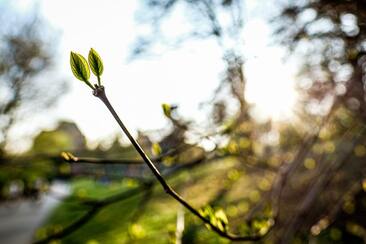 I've spent most of the week in the Blue Ridge mountains, on a much needed Spring Break trip with my fam and our friends/framily. (I hate that word, because it is so precious. But also, it is the right word sometimes. Especially during these quarantine days, when ‘framily’ are the only people we have had around for more than a year). After a few days of driving and hiking these mountains--on a day when we have some particularly squirrelly kids in the backseat, and a confused/homesick dog, and the men-folk are out doing mountain men mountain biking things-- I say to my friend, “is it just me, or do all these trees look...dead?” I mean, everything else is blooming. There are flowers everywhere, and the evergreen brand of trees are looking all bright and aggressively spring-like, and the grass is neon green and just begging to be a deer snack, and life in general is coming up roses. But half of the trees in the forest around us seem… well, they have seen better days. “A little sus,” as the kids would say. Completely dry, barren and brown. Kindling. It’s not looking good. But maybe I have no idea what I’m talking about? “No,” my friend says, “I thought so too.” It really does look like half the Pisgah National forest has just decided to call it. Pandemic year + climate change + downfall of civilization. Who would blame a tree for just giving up the ghost? I was concerned. For the hawks swooping hopefully overhead. For that deer in the road that stopped and, I swear, looked us dead in the eye for a second before sighing and sauntering off into her dying habitat. For the bears that supposedly lurked in the shadows, waiting to eat our trash--but who had remained on the DL for the duration of spring break and so, must surely lurk on the brink of extinction as well. It is possible we’re all in a fatalistic mood these days. Can you blame us? Because, let’s be real. Look around. The earth is a dying life form. We are just accessories. But on the third day… Early in the morning, on the third day, while it was still dark--it started to rain. I don’t mean a cute little spring shower. I’m talking cats and dogs here. A gully-washer, a deluge, a downpour. For about 12 hours straight. The earth got a generous soaking while we slept. And by mid-morning, when I ventured out onto the porch with my coffee (and if there is anything better than vacation coffee on the porch, in the mountains, in the rain, then I don’t know what), the first thing I noticed was--green. Everywhere. All those dead-looking trees had bloomed overnight. In the cold, in the dark, in the holler, a tiny bud just waited to be called out by the rain. In its time, it came. Maybe Ma Nature didn’t get the memo that Easter was not for a few more days yet. But she beats the pants off the liturgical calendar, every single time. For my money, in this year that has felt like one long winter/Lent/Holy Week of holding our collective breath, the breathtaking suddenness of that green was about all the church I needed. As Roethke said: "deep in their roots, all flowers keep the light." Everything in its season. All things bloom in good time. Or, if you prefer the gospel of Springsteen: "everything dies, baby, that's a fact/but maybe everything that dies someday comes back." May it be so. Amen.  I got braces this week. And not the magic “invisible” kind. Full on wires, metal brackets, the whole deal. It’s kind of a long story, involving years of jaw problems that, ironically, multiple professionals have told me were CAUSED by the orthodontia I had when I was younger. It was pretty extensive, involving a couple years in a palate expander, some other tedious procedures, and nearly 5 years in braces. (When they finally came off my senior year of high school, all I wanted to do was kiss boys, free of hardware). Apparently, in the old days, all they cared about was the aesthetics of getting our teeth straight and pretty. They weren’t looking at our whole bodies, considering things like growth and alignment. And so, for a lot of us, all that manipulating caused longer term, whole body issues. The irony is not lost on me that I am wearing braces to fix issues caused by braces. If I overthink that it keeps me up nights. I feel like a teenager again, and not in a good way. Much of the experience is exactly as I remember -- the cuts and scrapes on the inside of your mouth, the difficulty of learning to eat and talk around the metal, and the feeling of some foreign body being always a part of your body… But here’s what’s interesting-- I also remember my mouth being really, really sore the first few days after getting a new wire on. But this time, there is no pain. Well, aside from the minor lacerations on the inside of my lip, but you know. My actual teeth aren’t sore. Could it be that my teeth remember where they are supposed to go from all those past years of wrangling, and so they just snapped back to attention immediately with no fuss or drama? Our bodies are amazing. They remember. I used to be a dancer, and to this day, I can easily fall into certain kinds of movement without even thinking about it. A certain song will make me remember an entire combination, something I must have practiced hundreds of times before a performance or competition. While the execution might be lacking, the muscles remember. I mean, I can no longer manage a toe touch in the air and land in the splits; and for the safety of all around me, will not attempt such things at 40-plus. But my muscles remember how to get there, and what to do next, and how to move into the next thing after that. I dance in my sleep sometimes. During the pandemic I’ve gotten on the virtual fitness train. I’ve been doing a lot of HiiT and weight training, but was getting bored with that. I thought I’d try the whole Barre thing that is all the rage, and I was so happy when I realized it was not just a ballet-based workout but actual ballet. I was ready to dig out ballet shoes and go get my old barre from my mom’s basement. It was not lost on me that this ‘workout’ is comprised of exercises that, at one time, were just a warm-up for hours of actual dancing--but still! I was all in. A few days into this new routine, my hips started hurting. I thought it might be my desk chair, or my shoes, or some other external factor. But by process of elimination I figured out that the real culprit was the ballet life I was trying to reclaim. My hips just did not want to do that anymore. For the uninitiated, ballet--even just the warmup barre exercise--requires a certain rotation from the hips, a “turnout” that you hold through every movement. If you have not been training your body to turn out for years, it does not come easily. In fact-- I never had great turnout, because I didn’t start ballet until I was about 13. At which point, you are basically grown. There are many things you can learn and condition your body to do. But turnout is just not one of them. Which I just recently remembered. Or rather, my muscles remembered for me. My body told me that I am a grown-ass woman and somebody’s mother and maybe now is not the time to dust off my dreams of being a professional ballerina. And I’d better not dare even THINK about trying on some toe shoes. However, there are plenty of miraculous things my body is capable of, dance related and otherwise, that need not cause pain and suffering. On a side note, I’m concerned that the fitness industry is pushing these ballet-based fitness regimes for grown adults whose joints and muscles are not trained to turn that way. I’m wondering how many other middle aged women are waking up with aches and pains that they think they just need to power through, like any other sore muscle, not realizing that there is something really unnatural about some of those movements, and that your body will actively protest if you haven’t been working towards this since you were 5. On a more existential note, I’m just over here marveling at what our bodies remember, for better or worse. And what they can tell us, if we listen. Speaking of listening-- we have a new podcast episode! Check out our interview with Kory Caudill, one of the top pianists in the world. (And we aren't just saying that because he's our people). We are dust, you know?
It need not be a churchy thing, to think about this. It need not always be marked on our heads, the dark stain of our living and someday dying. It is a thing we know in our bones, maybe especially when we have been sequestered for going on a year that feels like many more. Do we need to cover our faces with dirt, when already they are masked when already we know that even breathing can be a dangerous business in these frail human forms? We are plenty practiced in rending our hearts, have scattered ashes far and wide to the very ends of the earth. We are covered in dust. Have been daily called up into this knowing of our eventual end. We are marked. We are reminded. This season is redundant. And what can we give up or lay down that has not already been taken? What small joy or comfort has not already been added to the long list of things unsafe, untouchable? And yet, we lean towards a dim winter light that lingers near the corners where two dark lines cross in the middle. And let the artist's stroke tell the story of all the miraculous life that dwells in dust and darkness all the beginnings marked by ashes and the endless wonder of having nothing left to lay down. 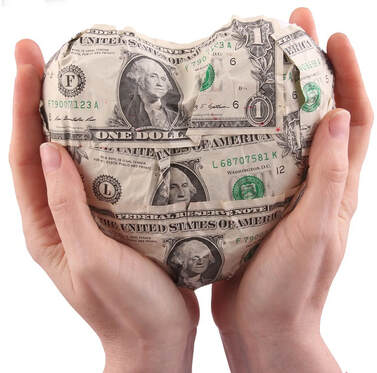 Americans will spend about 21.8 Billion dollars buying Valentine's stuff this year. That's nearly $4 billion more than it was last time I looked up that number, about 4 years ago. When I think about what we could do, collectively, with nearly $22 billion, it boggles the mind. No, scratch that-- it literally breaks my heart. For one thing, it would cover our National Parks budget for about 8 years. Or fund the National Endowment for the Arts for a few decades. How many hungry children could be fed? Student loans forgiven? Refugees resettled? We could make a longer list, but you get my point- we have the resources in this country to do so much collective good; to meet so many needs; to solve so many complex problems. But when you come right down to it-- our hearts are just in all the wrong places. Valentine's Day itself is not the problem. A holiday designated for love? Sure. Fantastic. But... when did “love” get saddled with all this stuff? Billions and billions of dollars worth of stuff? I’d venture that most of the billions are spent on flowers, jewelry, stuffed animals, and any other number of things that come in the shape of a heart. Which, by Monday, will be marked down 80% at Walgreen’s and Target and every other store in America. Not long after that, much of it will be in a landfill. This holiday is just one of many that draws attention to our consumer sickness. That sickness is big, and multi-layered, and it’s not Saint Valentine’s fault. It’s also not the fault of Baby Jesus or the Easter Bunny; or Saint Patrick, the Great Pumpkin or Uncle Sam. On every one of these days, we wade through the sea of sugar and cheap plastic crap that will ultimately flood the landfills we use to hide our addiction. The dam will only hold for so long. So there’s an environmental concern, and a sweatshop concern. But more than anything, there's a heart concern, underlying all the paper and diamond ones. The real emptiness that might make us feel like we *have* to buy this stuff, or else we have somehow failed at the whole love thing. More to the point, this is an illumination of the scarcity mentality… The one that tells us we cannot possibly afford to insure all of our children–or educate them, or provide them with clean water and air, or protect the resources for their retirement someday–when clearly, we have all the money in the world to spend on… What, exactly? Another engraved picture frame? Another charm for that bracelet? Another bear holding a heart? (What can I say, SNL gets it). Can we fix all of these complex problems by abstaining from flowers and stuffed animals today? Maybe not. But practicing a bit of mindfulness about our own spending and gifting can go a long way to change our thinking about what is needed, what is important, and what is worthwhile. And that shift might, in turn, change our thinking about what we can, and cannot afford… As a family, as a country, and as people who have to inhabit this earth together long after the landfills overflow and the rivers run dry. Here are a few ideas for how to celebrate this day of love without breaking the bank–or contributing to our collective national junk pile.
This is modified for COVID times from a post that originally appeared on Patheos. 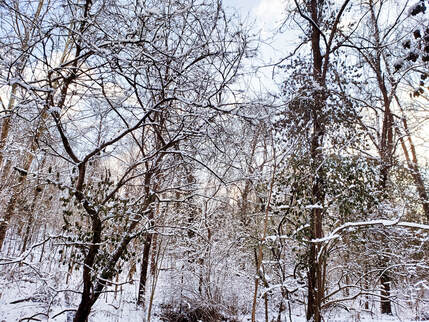 I use stock images sometimes- but actually took these myself! Goose Creek trail. I use stock images sometimes- but actually took these myself! Goose Creek trail. Historically speaking, January and I have not been friends. Blame it on the cold, the post-holiday letdown, or the fact that January is about as far as a month can be from October (except for November & December, but they get a pass on account of holidays). For the seven years I lived in Arizona, January and I had a respite from our adversarial relationship. In the southwest, that window of time is a sparkling paradise -- perfect for drinking spicy Mexican lattes and hiking desert mountains under crayon-blue skies dotted with hot air balloons. And also, you know, a nice break from the other months that will melt your face right off and not even feel sorry about it. It's possible that, since leaving that winter utopia, I've felt even more frigid towards the first month of the year. And January in a pandemic? I've been dreading it, hard. The cold and the gray, plus the isolation and anxiety, and the lack of things to look forward to... It felt like a lot this year. The attempted overthrow of the government didn't help, but at least I saw that one coming. I looked at my calendar this week and noted that January is ALMOST OVER! And yet... winter is not done, by a long shot. Neither is the pandemic. Or the escalating political discord that really piles on to the usual heaviness of the season. We've got miles to go yet, on all counts, and we all need some coping devices to get us through. I'm not telling anybody how to live their lives, but here are a few of the daily verbs that have been holding me up through this season:
Speaking of reading--my daughter has been reading The Long Winter, a book in the Little House/Laura Ingalls Wilder series. I never really got into those as a kid, other than little snippets here and there. But I'm familiar with the gist of this one: it's winter, it's cold, they have no food, everything is terrible, they almost die. The end. And get this-- my kid has read this before and is reading it again on purpose. For fun. I said "why in the world would you want to read that right now?? Isn't it so depressing?!" And do y'all know what this tiny thing said to me? She said, "Well, parts of it are sad. But it makes me feel happy because in the end... it's spring." Well. Let the child preach. Here in my end of Kentucky we got a beautiful big snow this week-- the kind that looks nice and is fun to play in but melts off the road quickly. I walked over to creek (crick) in my neighborhood just to stand there on the path in a quiet, wooded place for minute. The canopy of icy branches, almost cartoonishly magical, reminded me that winter does have its own kind of beauty some days, its own spiritual gifts, if we can be wise enough to witness. Meanwhile, the water running over the rocks of the creek bed sang its own song -- spring is coming. Seems like my kid and my creek have the same good news to share this week. Finish the book. Stay in this story, however sad and heavy it feels. In the end, it will be spring. |
Archives
March 2023
Categories
All
|
